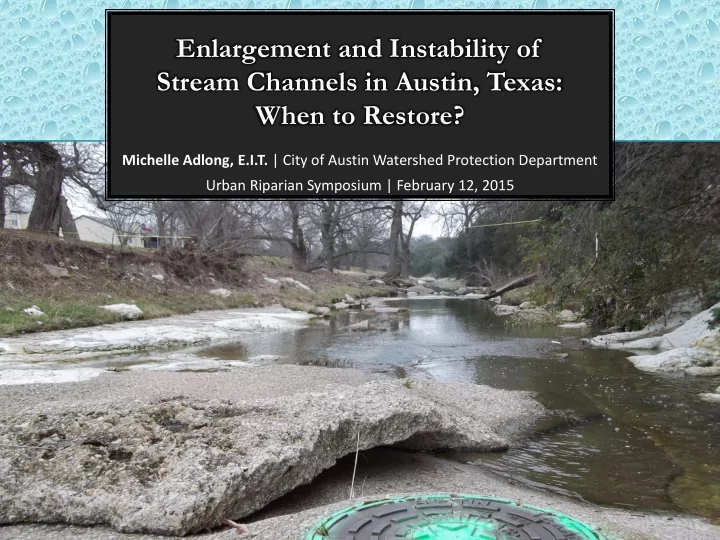

Enlargement and Instability of Stream Channels in Austin, Texas: When to Restore? Michelle Adlong, E.I.T. | City of Austin Watershed Protection Department Urban Riparian Symposium | February 12, 2015
STABILIZATION AND RESTORATION What type of restoration is most appropriate?
A STREAM IN EQUILIBRIUM 𝑹 𝒕 × 𝑬 𝟔𝟏 ∝ 𝑹 𝒙 × 𝑻 Lane’s Balance: Flow Stream Sediment Particle Discharge Slope Discharge Size Sediment Load Stream Power Source: ASCE
CHANNEL EVOLUTION MODEL (CEM) • Understanding a stream’s stage in channel evolution helps select appropriate restoration techniques • Passive vs. active restoration • “Watershed restoration” another approach
INITIAL STABLE CHANNEL Source: Fish Creek Coalition • Original stable channel: sediment load and stream power are in Restoration Method: equilibrium Passive • Typically channel is vegetated and Active well-connected to floodplain
STAGES I AND II: DISTURBANCE AND INCISION Source: Fish Creek Coalition • Watershed development ( Δ Q w ) or Restoration Method: channelization ( Δ S) typically increases Passive stream power, interrupts equilibrium Active • Response: Incision and headcutting
CEM STAGE III: WIDENING Source: Fish Creek Coalition • Incision leads to steep, overly high Restoration Method: banks Passive • Altered hydrology increases shear forces on banks Active • Result: Bank failures, erosion, widening
CEM STAGE IV: AGGRADATION AND PLANFORM ADJUSTMENT Source: Fish Creek Coalition • Decrease in stream power due to Restoration Method: widening Passive • Deposition of sediment carried from Active upstream degrading reaches causes aggradation, formation of bars
CEM STAGE V: QUASI-EQUILIBRIUM Source: Fish Creek Coalition • A new inset floodplain and bankfull channel Restoration Method: forms in the aggraded channel Passive • Evolution process takes many years, even after disturbance in the watershed has stabilized Active • Stable does not imply static flowpath
HOW HAVE AUSTIN’S CREEKS EVOLVED? Channel Enlargement Study • 1 to 3 cross sections at 45 sites in Austin watersheds • Sites were re- surveyed in 2015 (in progress) Tannehill Creek at Givens Park in 2015
WATERSHED EROSION ASSESSMENT GEOMORPHIC SURVEYS Survey Procedure • Select cross section location at wastewater lines • Survey cross sections in 1997 and 2015 1. Wastewater line alignment 2. Perpendicular & downstream of wastewater line • Note locations of flowline, active bankfull channel, top of banks • Observe channel type, channel features
DEFINING CHANNEL GEOMETRY
WATERSHED EROSION ASSESSMENT GEOMORPHIC SURVEYS Calculations Channel Geometry • Active Bankfull Elevation, z abf 𝑆𝑓 = 𝐵 𝑢 • Top of Bank Elevation, z top 𝐵 𝑢 0 • Cross Sectional Area, A • Top Width, W 𝑆𝑓 𝑢 − 𝑆𝑓 𝑢 0 • Flow Depth, D 𝑆𝑓 = • Hydraulic Depth, D Hyd 𝑢 − 𝑢 0 • Width : Depth Ratio, W/D Hyd 𝐽𝐺 = 𝐸 𝑢 𝐽𝐺 𝐼𝑧𝑒 = 𝐸 𝐼𝑧𝑒,𝑢 Change over Time 𝐸 𝑢 0 𝐸 𝐼𝑧𝑒,𝑢 0 • Enlargement Ratio, Re 𝑋/𝐸 𝑢 • Normalized Enlargement Rate, 𝑆𝑓 W𝐺 = 𝑋/𝐸 𝑢 0 • Incision Factor, IF
2015 SURVEYS 2015 Survey Locations (So Far) 1997 Survey Locations
PRELIMINARY RESULTS Enlargement Ratio over Time (Reference: Active Bankfull)
PRELIMINARY RESULTS Incision Factor (Hydraulic depths taken from geometric top of bank) By Watershed
PRELIMINARY RESULTS Width : Hydraulic Depth Ratio over Time By Watershed
PRELIMINARY RESULTS Width : Hydraulic Depth Ratio over Time By Channel Type
LITTLE WALNUT CREEK EXAMPLE SECTION Section 18 Approx. 2500 ft upstream of Cameron Road • Bedrock bottom channel • Mowed on left side, natural on right 2015 1997 Looking downstream through section
TANNEHILL BRANCH EXAMPLE SECTION Section 54 50' D/S of Confluence with Tannehill Tributary in Givens Park • Initial downcutting and widening • Erosion of steep bluff on right bank • Reestablishment of inset channel 2015 1997 Looking downstream through section
BUTTERMILK CREEK EXAMPLE SECTION Section 83 Behind Lot 110 off of England ROW • Clearing of banks • Widening • Possible meandering of bend • Stormwater infrastructure 2015 1997 Looking upstream through section
CONCLUSIONS • Development disturbs channel equilibrium, sets in motion years of channel evolution • Geometry of channel also depends on stream type • Restoration projects should evaluate stage of channel evolution as well as other geomorphic factors on a site by site basis • Passive restoration alone could be undermined if channel instability is not taken into account • Channel geometry is one, but not the only, way to evaluate channel stability
THANK YOU Clayton Ernst Sean Thompson Chris Adams Morgan Byars Stephen Davis
TANNEHILL BRANCH ENLARGING SECTION Section 53 Givens Park upstream of confluence with tributary • Outside of bend • Mowed to top of bank • Informal trail 2015 1997 Looking downstream through section
Recommend
More recommend